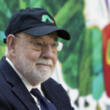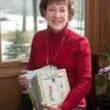The Apple Pie Tree
(Libby/OverDrive eBook, Kindle)
Available Platforms
Description
More Details
Also in this Series
Published Reviews
Booklist Review
Ages 4^-7. Two young sisters describe the changes that occur in their backyard apple tree throughout the seasons of a year. The tree is bare and brown in winter, but spring brings two robins that build a nest and raise a family amid the apple blossoms. In summer, the robins fly off, the girls enjoy playing in the tree's shade, and the apples grow bigger and redder. Finally, in autumn, they pick apples and bake a delicious apple pie. Halpern's colorful collage illustrations perfectly complement the succinct text. Eschewing the use of backgrounds, she concentrates on the tree and the children, which results in crisp edges and an uncluttered appearance that will please young audiences. Appended with an explanation of pollination and a recipe for apple pie, this will make a perfect choice for fall story hours and primary science lessons. Pair with Gail Gibbons' Seasons of Arnold's Apple Tree (1984) for another perspective. --Kay Weisman
School Library Journal Review
PreS-Gr 1-From bud to fruit, two children follow the cycle of an apple tree as it is nurtured through the seasons. The book incorporates the role of bees and the weather in the production of the fruit. Another use of the tree is shown, as a pair of robins build their nest and begin a family. The story ends with a nice, warm apple pie being taken from the oven. The large pictures and text are suitable for young children. The colorful, clear-cut illustrations use a paint and paper collage technique. An end note shows how bees pollinate the tree's flowers and offers a recipe for apple pie. Great for sharing with a group or one-on-one.-Kathy Mitchell, Gadsden Co. Public Library, Quincy, FL (c) Copyright 2010. Library Journals LLC, a wholly owned subsidiary of Media Source, Inc. No redistribution permitted.
Horn Book Review
Two young sisters witness the changes in their apple tree from winter to autumn, as leaves, then flowers, then finally apples grow, ready for pie-making. A nest in the tree holds baby robins, whose development also helps define growth in a clear, child-centered fashion. Vivid collage illustrates the simple text. A final page contains a pie recipe and simple explanation of the bee's role in pollination. From HORN BOOK 1996, (c) Copyright 2010. The Horn Book, Inc., a wholly owned subsidiary of Media Source, Inc. No redistribution permitted.
Kirkus Book Review
A simple nature story about an apple tree in winter, spring, summer, and fall. ``My sister and I have a tree that grows the best part of apple pie. Can you guess what that is? Apples!'' In winter, the tree is brown, but in spring, leaves grow and a robin nests in the branches. In the days that follow, buds, blossoms, bees, tiny apples, and mature fruit appear. In the final pages, the two girls (with help from adults) make and eat an apple pie. A recipe is included, as is information on how the bee pollinates the apple flower. Halpern uses soft greens, browns, and pinks in the cut- paper collages; careful shading, painting, and layering give the illustrations dimensionality, with the textured nest and marbled tree trunk especially effective. An appealing study for young children. (Picture book. 4-7)
School Library Journal Reviews
PreS-Gr 1-From bud to fruit, two children follow the cycle of an apple tree as it is nurtured through the seasons. The book incorporates the role of bees and the weather in the production of the fruit. Another use of the tree is shown, as a pair of robins build their nest and begin a family. The story ends with a nice, warm apple pie being taken from the oven. The large pictures and text are suitable for young children. The colorful, clear-cut illustrations use a paint and paper collage technique. An end note shows how bees pollinate the tree's flowers and offers a recipe for apple pie. Great for sharing with a group or one-on-one.-Kathy Mitchell, Gadsden Co. Public Library, Quincy, FL
Reviews from GoodReads
Citations
Hall, Z., & Halpern, S. (2017). The Apple Pie Tree . Scholastic Inc..
Chicago / Turabian - Author Date Citation, 17th Edition (style guide)Hall, Zoe and Shari Halpern. 2017. The Apple Pie Tree. Scholastic Inc.
Chicago / Turabian - Humanities (Notes and Bibliography) Citation, 17th Edition (style guide)Hall, Zoe and Shari Halpern. The Apple Pie Tree Scholastic Inc, 2017.
Harvard Citation (style guide)Hall, Z. and Halpern, S. (2017). The apple pie tree. Scholastic Inc.
MLA Citation, 9th Edition (style guide)Hall, Zoe, and Shari Halpern. The Apple Pie Tree Scholastic Inc., 2017.
Copy Details
| Collection | Owned | Available | Number of Holds |
|---|---|---|---|
| Libby | 87 | 87 | 0 |



































